




| Home | Features | Club Nights | Underwater Pics | Feedback | Non-Celebrity Diver | Events | 21 August 2025 |
| Blog | Archive | Medical FAQs | Competitions | Travel Offers | The Crew | Contact Us | MDC | LDC |

|

|
 
 |
 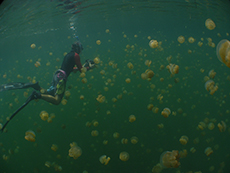 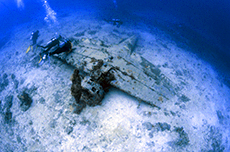 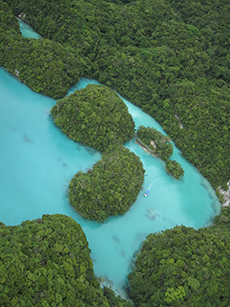  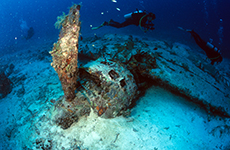 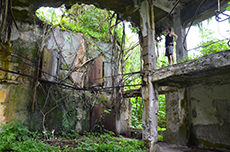 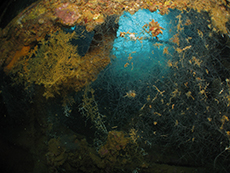 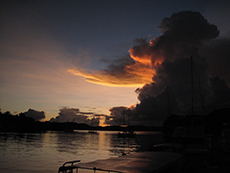 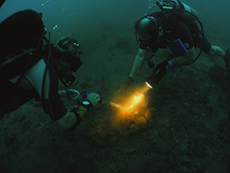 ISSUE 17 ARCHIVE - PART OF THE FAMILY: DIVING IN PALAUHoward SawyerWhen my planned trip on a luxury liveaboard to the Sudanese Red Sea fell through, due to insufficient numbers, it wasn’t a disaster. There was always plan B; a plan so simple, so brilliant, it’s a wonder why any diver would need plan A in the first place.Now there’s a tech diver, built like a Cornish tin mine, who’ll happily tell you that the best diving EVER involves thermals, a pee valve, four torches, and is in North Utsire, or one of those equally inhospitable waters from the shipping forecast. In January. And if he ever gets together with ‘Big_Don50’ and the other like-minded slap heads off the internet, there’ll be standing room only. In a revolving door. For us less hardy souls there’s Palau, a tiny splatter in pale Pacific Blue, down and to the right from the Philippines, up from the ‘A’ in ‘I N D O N E S I A’. It’s so in the middle of nowhere, there’s not even a destination posted on the departures board in Manila. Just a flight number in the middle of the night. Reassuringly the Continental Airlines check-in staff know enough to charge an extra thirty bucks for the dive kit. Mexico is renowned for spectacular caves, the Philippines for critters, Dahab the Blue Hole, Chuuk the wrecks, Bahamas the sharks, and with apologies to Dexter, one of Palau’s legendary dive guides, there’s at least one wall in the Solomons that beats his hands down. But only in Palau will you find all this diversity, and more. And all within fifty minutes of the dock at Koror’s Malakal harbour. Even in comparable exotic locations, such as Papua New Guinea, you still have to fly between draw card dives. In Palau you simply dump your bag, set up your kit, and the world of diving from 0 to 40 metres is served up on a plate. I’ve thought about this long and hard, and the only thing that’s missing is an installation: a submerged sculpture park of lifelike figures, so in vogue in the Caribbean. There again, only Palau has Jellyfish Lake. And did I mention Blue Corner? This is world class diving, or even better. Some may crave the pampered prison of an exclusive island resort, where you’ll have to bribe a boat boy every time you fancy a doughnut. Rest assured, Palau has a variety of swanky retreats if you simply must pay top dollar for bottled water, but there’s also budget accommodation, which is why I’m here. You can take a liveaboard if you must do five dives a day, but you’ll hit the same sites as the day boats, and I hear they charge extra for nitrox. In the dive hub of Koror, eateries cater to every palate and you can walk the streets, day or night, without hassle. Try that in PNG and see how far you get. Indeed Palauans habitually engage visitors to discover where you come from, and what you think of their country. You might have a local bark at you like a dog on a Friday night, but I’d suggest we’ve all been there. Sam Scott started his diving business with a small boat and five bucks from his stepfather, one of the paramount high chiefs of Palau. He cut a door in a shipping container to make an office, and lived in another next door. ‘Sam’s Tours’ was born. Marketing manager Marc Bauman tells me that originally, although a diver, Sam didn’t guide, but skippered the boat. “He’d take guests out to the site and he’d tell them, “You get in here and I’ll pick you up over there!” That was twenty years ago.” The waterfront base has subsequently undergone four major renovations and now boasts a flotilla of thirteen vessels including nine dive boats, and caters for everything from kayaking and land tours to tech dives. There’s a retail shop, photographic and video centre, and a superb bar and grill that serves everything from pancakes and bacon at sunrise, to sushi and tequila at sunset. But that is just what you see on the surface, before you dive. It’s not what you feel. Marc Bauman articulates what makes this shop so special. “I coined the phrase, “It’s the Sam’s Tours Family”. Once you dive at Sam’s you become part of the family. A lot of places you go it’s very corporate, very clinical, and you’re a number. With smaller operators you feel like family, because they only handle a small amount of clients, and Sam’s still has that feel. That’s really rare for a company of this size. We’re no longer a dive shop. We’re an international brand - and we fight every day to make it not like a corporate thing.” This requires a delicate balancing act. They’re conscientious of the fact that the more divers they drop on the reefs, the greater the environmental impact. “We never wanted to be the biggest. The goal is not to have so many divers that it takes away from the experience. My goal is that every guest says, “That was the most amazing diving experience I’ve ever had.” Even with their impressive track record of international awards and perennial returning family members, Sam’s vibe transcends diving. At my digs I meet David, a retired US medic with the Cleared Ground demining project, removing WWII ordnance from Peleliu. If you watched the TV mini series, ‘The Pacific’, you’ll want to take the day trip. He illustrates just how powerful the brand is. “I don’t dive, but if I did, I’d dive with Sam’s Tours.” You can’t buy word of mouth like that. Marc Bauman tells me their magic ingredient. “The customer service level and the staff. These young men and women are remarkable people. A journalist came to do an interview with us, and he said something I’d never heard before; “You can always tell the mark of a great company like this by how many people hang around after work.” We were having dinner, looked around - there must’ve been twenty staff, and it’s already eight in the evening.” Despite of all of this great PR, some divers still bring misconceptions with them. The Germans for instance; “Ya - it’s great here, for sure. But I think, for macro, Philippines is better.” Veteran guide Jim Wilke vehemently disagrees. ‘There’s plenty of macro here, but people don’t come to Palau for macro, not when it’s all kickin’ off at Blue Corner. See this little wall outside the shop? We have mandarin fish - right here! Who’da thought, huh? Grab a tank an’ jump in, Dude!” Late afternoon is a good time. And you don’t need to be tooled up with certification cards, or pack like Buzz Lightyear either. Jim can hook junior scuba divers into Blue Corner at 12 metres. Of course he can, he has thousands of dives here. The PADI Blue Corner Speciality Course Sam’s Tours developed isn’t just for show, as I’d originally thought. Canadian dive guide Alexandra Young explains that there’s fans on the signature site that face the surface, catching nutrients from currents running down the wall. As Marc Bauman tells me; “For you to be a dive leader at Sam’s you have to have a minimum of 200 dives on Palau’s reefs before I let them take a guy like yourself out. So they’ll be a backup guide for three months. You can come to me with 10,000 dives on your résumé, and you’re still going to be a back up guide. And these guys will gladly do it.” The staff are already at work in good humour when I arrive for breakfast just after 7 am. I’m introduced to my guide, Marc Cruciani, from Virginia. He’s a full blown techie, rebreather, cave and wreck specialist, with an easy going manner to compliment his leisurely southern drawl. Most of the wrecks I’m interested in, the aftermath of Operation Desecrate One during WWII, are seldom dived. “I don’t know these wrecks personally, but I do know wreck divin’!” Ladies might even describe Marc as ‘fit’. He’ll have to do. The day boats leave and the hubbub subsides. We saddle up ‘Black Tip’, the tiny cockleshell Sam built his empire on. A fifteen minute slalom through the picturesque rock islands and we’re bobbing over ‘Iro’, the Japanese navy fleet oiler and supply vessel. We drop down the mooring to the bow, then over the port side to 35m to examine the torpedo ‘bite’, taken from the prow on 22nd March 1944, when en route from Balikpapan, Philippines. The watertight forecastle saved the ship on this occasion, and she limped into Palau. It was a brief stay of execution. She was hit by the opening aerial salvos on the first day of Operation Desecrate One, eight days later. The following day she was set ablaze by further sorties from the carrier based dive bombers of the USS Yorktown, and sunk upright on the seabed at 40 metres. Returning to the deck at 30 metres we traverse the huge radial gun platform decorated with hanging coral; a sister gun sits aft. The entire wreck is stubbornly encrusted with clam and coral along its 120 metre length, the fire seemingly sterilising every exposed surface, encouraging the prolific growth. Before us the king posts and cat’s cradle mast work stretch skywards and the superstructure invites a slightly creepy dog leg swim through. The companionways yield a row of bare cabins, golden silt piled and flecked against the dark walls. A solitary beer bottle, conveniently atmospheric, stands on a ledge in the forward hold. Gnarled, gargantuan, eerie; Iro is a magnificent sunken Mary Celeste. Local knowledge says visibility decreases towards the stern, but as we climb aboard ‘Black Tip’ I assure Marc I’ve experienced visibility twice as good on the wreck as the 8 metres we’ve enjoyed today, and although I sense his scepticism, by the end of my trip he’ll believe me. Ian Mills of Cardiff Scuba joins us and provides another pair of eyes for the afternoon’s exploration of the Teshio Maru, an aquarium wreck just under 100 metres in length, lying on her starboard side on a sandy bottom at around 25 metres just off the Palau Pacific Resort. A Japanese army cargo ship, she was attacked by Grumman Avengers, single engine torpedo bombers, launched from the USS Bunker Hill. She stuck on a reef in the chaos of the attack, but was later refloated, or slipped off, depending on which account you read. Although salvaged, this is a beautiful carcass that enjoys stellar visibility by Palauan wreck standards, and frankly I don’t know why she’s not dived more often. Whilst Iro sits aloof, like some Gothic Dowager Empress, the perfect backdrop for a horror film, the Teshio by contrast is sunlit, airy, and an ideal wreck for the novice and the experienced alike, with little or no current, and plenty of features; rudder, ladders, winches, derricks, a brightly encrusted pulley, mosaic floor tiles, an exposed boiler and ornate deck gun mounted on the bow. Teshio affords an easy 20 metre swim through for first timers with a superb specimen of staghorn coral at the end. Indeed the wreck boasts a variety of pretty marine life with whips, soft, plate and black coral supplemented by a variety of reef fish. But for sheer scale, both Iro and Teshio rest in the shadow of Amatsu Maru. Less than 10 minutes from the dock, this 10,000 ton tanker at 153 metres long, is a fraction less than Chuuk’s largest wreck, the former luxury liner Heian Maru. Hit several times along her length, Amatsu went down by the stern. Upright and intact at approximately 43 metres on the seabed, this would be an ideal tech or rebeather dive, but even on air you’ll still want to see this wreck. Two or three dives will give you an appreciation. The massive four blade propellor, some 6 metres in diameter, is visible at 39 metres. Salvage began post war, with the removal of 8,000 gallons of oil, but a subsequent explosion, reportedly when a diver using a cutting torch hit a pocket of trapped gas, killing himself and a colleague, convinced the Japanese to abandon further operations. The wreck is smothered in black coral trees, giving Amatsu the aka moniker of ‘The Black Coral Wreck’. The bridge area can be penetrated through the ceiling beams, where a small empty safe can be found. The superstructure is as big as a house and there’s a beautiful intact catwalk leading from the pump house roof. We tick off the list of wrecks one by one. The LST 1 landing craft, twisted mid ships, with AA guns, a rectangular swim through hatch, and a lively-looking shell lying on the seabed just off the starboard side, the picturesque Japanese Aichi E13A reconnaissance seaplane, and probably Palau’s best treasure trove, the unidentified ‘Helmet Wreck’. Named after the fused Japanese tin hats that lie in the aft hold, ‘Helmet’ also contains numerous deep charges, now corroding, and slowly seeping picric acid. Dive here at your own risk, if you can find a guide willing to take you. You will be exposed to the chemicals even if you touch nothing. Most of the nicknacks are on the upper deck, including a gas mask, rifle, and a box of fuses. But the gems lie forward; three aircraft engines in the hold, and in the forecastle locker, a collection of beautiful storm lanterns. By the end of the week the daily schedule board shows a growing list of other divers wanting wrecks, including Ken, from the UK, and his buddy Ryan from Nebraska. They’ve eyes the size of dinner plates after an exceptional encounter with eighty plus sharks at Blue Corner, but Ryan’s dived there four times already this trip. “Do I have to dive it again, man?” I turn to Marc with the immortal line; “You’re gonna need a bigger boat.” So we upgrade, and although I play down the visibility and the lack of encounters with pelagic species, so no one’s disappointed, to my surprise everyone has a great time. It’s something different, a side of Palau many divers don’t get to see. Marc grins; “I was telling the other guides, I ain’t had no more n’ 15 meter vis this week, an’ I’m as happy as a pig n’ -” “Chuyo Maru this afternoon?” “Sounds like a plan, Dude!” Bird is the Word Although most divers understandably travel to Palau to see the underwater world, for an alternative seat-of-your-pants adventure, why not try seeing your dive sites from the air? Palau Helicopters offers daily flights of fifteen minutes to three quarters of an hour with pilot Matt Harris. They provide a complimentary pick-up service from the dive shops and hotels in Koror and the helipad is on the roof of their offices, so no need for the airport run. This is an unforgettable experience and the best advice I was given was to take the longer forty-five minute flight. This will afford you the opportunity to see not only the surreal turquoise waters of the ‘Milky Way’, and the chain of seventy islands beyond, but all the major dive sites. It’s a unique perspective to see Blue Corner, Blue Holes and German Channel from the air, and you’ve a good chance of seeing sharks, mantas and dugongs. The Bell jet ranger helo provides two-way headsets to enable in-flight commentary. The longer flight also features a low-level hair-raising adrenaline rush. Put it this way, after touch down my |